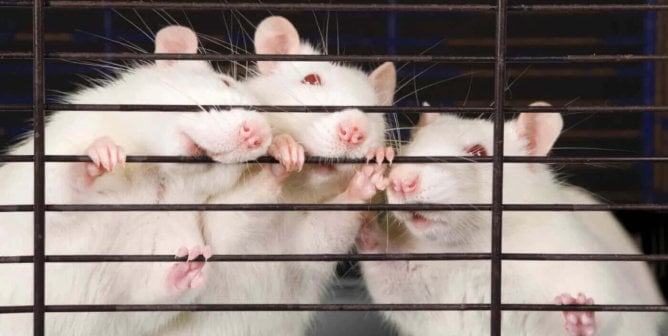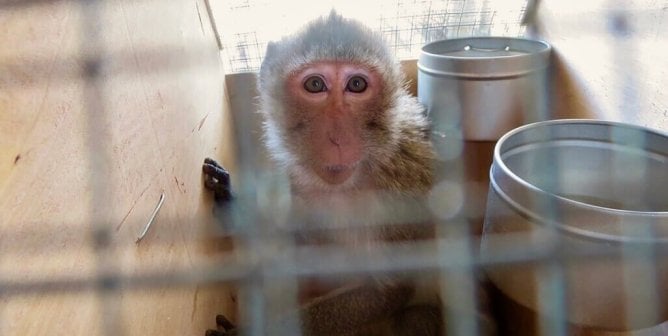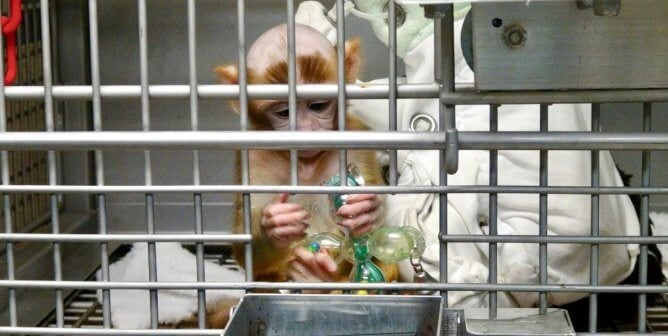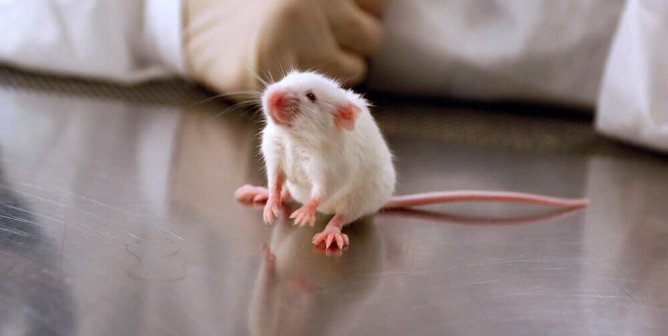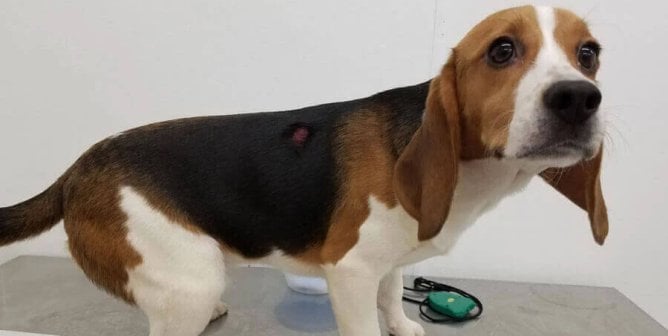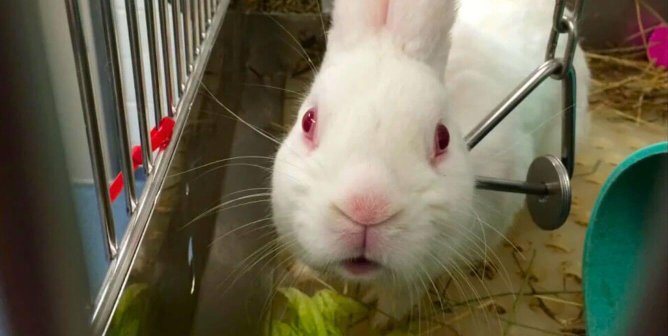PETA Shines a Light on the Reality of Animal Experiments at the University of Virginia
PETA is pulling back the curtain on taxpayer-funded animal experiments at the University of Virginia (UVA) to reveal shocking violations.
- Official Animal Welfare Concerns
- Number of Animals Used
- “Column E” Animals Used
- Examples of Animal Experiments
- Media Coverage
- Public Funding
Official Animal Welfare Concerns at UVA
Each year, UVA uses an untold number of animals in experiments, including dogs, pigs, sheep, rabbits, guinea pigs, hamsters, ferrets, tree shrews, prairie voles, woodchucks, mice, and rats.. Oversight agencies responsible for ensuring compliance with federal animal welfare standards have documented numerous issues at UVA.
UVA has publicly pledged its commitment to the principles of the “3Rs”: Replacement of animal-based models with innovative technologies, Reduction in the number of animals used in experiments, and Refinement of scientific methods to minimize pain and suffering. UVA’s Office of Animal Welfare webpage states that “the University prides itself on its animal care and use program and strives for research excellence while fully utilizing the 3 R’s of animal alternatives. Formal training in the care and use of research animals is an integral component of our animal research program, and is not only good practice but is required by federal regulations.”
However, the following incidents demonstrate serious ongoing issues with the use of animals at UVA:
January 23, 2024, U.S. Department of Agriculture Animal and Plant Health Inspection Service (USDA APHIS) Report (two violations)
- Two prairie vole pups escaped from an enclosure during a bedding change by an employee, who didn’t notice they had escaped. They were discovered after “another staff member opened the door to the main room, found the pups, and replaced them into their enclosure.”
- “Three mice from two cages died from water deprivation,” and the “daily health report could not be found” for a fourth mouse who had died on the same day. “The Attending Veterinarian and husbandry management were concerned that personnel may have compromised their attention to detail while working in haste.”
October 31, 2023, Self-Reported NIH OLAW Report (5B)
- A group of mice died after “the cage they were being housed in was erroneously placed on the supply cart after being transported between two animal facilities.” A day later, “the misplaced cage was discovered” and the mice “were found dead even though there were adequate levels of food and water available.”
October 31, 2023, Self-Reported NIH OLAW Report (5C)
- A rat was found alive after a worker failed to perform a “bilateral thoracotomy,” in which “severing the diaphragm” is done to confirm death, after the animal was subjected to an “overdose of [carbon dioxide].” The lab worker “was unsure why the [rat’s death] had not been confirmed following euthanasia procedures.”
May 12, 2023, Self-Reported NIH OLAW Report (4W)
- Six cages of mice were being housed in areas not approved by the IACUC, including the principal experimenter’s laboratory space. One of the mice “had been evaluated by the veterinary staff and euthanasia was strongly recommended,” but the mouse was later discovered still alive in one of the displaced cages, at which time the Office of Animal Welfare ordered that the animal “be immediately euthanized.”
March 10, 2023, Self-Reported NIH OLAW Report (4U)
- One year after a “special western diet containing dexamethasone” (a steroid) sickened and killed mice in an experiment, the diet was used again. Forty mice were found dead or dying during the 14 days that they received the experimental diet, and the use of the diet was stopped again.
- Five mice were found dead or dying after laboratory staff failed to monitor the animals post-infection at the frequency specified in the approved protocol. The animals weren’t killed in accordance with the approved protocol’s “humane endpoint” criteria (the earliest point in an experiment when an animal’s physical pain or psychological anguish may be stopped by the experimenter without compromising the experiment), and 17 cages contained excessively soiled bedding.
March 9, 2022, Self-Reported NIH OLAW Report (4K)
- Within 14 days of being fed a special diet containing dexamethasone (a steroid), an unknown number of mice were found either dead or dying. The dying animals were immediately euthanized, and the “adverse event” was reported to the IACUC.
October 28, 2022, self-reported NIH OLAW report (4O)
- Three mice who had undergone operations had incomplete surgery cards on which the required number of post-operative observations and administration of medication hadn’t been recorded. Only one of two required pain-relieving drugs was documented as having been administered.
October 28, 2022, self-reported NIH OLAW report (4P)
- Two cages of mice had incomplete surgery cards on which the number of post-surgical observations hadn’t been recorded. It’s unclear how many mice were affected by this noncompliance.
October 28, 2022, self-reported NIH OLAW report (4Q)
- Three mice who had undergone operations had incomplete surgery cage cards, lacking documentation on the number of post-operative observations and the administration of medication. It was determined that pain-relieving drugs had been administered but not documented. OLAW noted that “because the issue of inadequate recordkeeping and post-operative responsibilities appears to be prevalent in various studies involving different species and laboratories, a program-wide corrective approach may be necessary.”
October 28, 2022, self-reported NIH OLAW report (4R)
- Three birds who had undergone operations had incomplete surgery cage cards that didn’t reflect the number of post-operative observations or the administration of medication.
October 28, 2022, self-reported NIH OLAW report (4S)
- Three mice who had undergone operations had incomplete surgery cage cards that didn’t reflect the required number of post-operative observations or the provision of pain-relieving drugs.
October 28, 2022, self-reported NIH OLAW report (4T)
- A worker noted that a mouse had a facial lesion but failed to report the injury to a veterinarian. The mouse was examined, found to be in pain, and killed.
August 11, 2022, self-reported NIH OLAW report (4M)
- Workers deviated from approved protocol and housing and husbandry standards specifying that tree shrew cages for breeding pairs and nursing females should be sanitized monthly, while cages for other tree shrews should be sanitized every two weeks. In this case, all tree shrew cages were being sanitized monthly. During this time, the animal population exceeded the available housing, leading the facility to use alternate caging for some animals.
August 4, 2022, self-reported NIH OLAW report (4N)
- Four dying or dead mice were seen on the ground near a research building housing animals. An animal handler admitted to having “released” approximately 45 mice due to a “mental breakdown” related to performing euthanasia and being unable to kill additional animals. The worker later resigned.
March 9, 2022, self-reported NIH OLAW report (4L)
- A tree shrew was used in a behavioral study in which he was given water containing 4% citric acid. After receiving this water daily for seven days, the animal was found dead. A necropsy revealed that the animal had likely died from water deprivation. The approved protocol specified that if a large decrease in water consumption or weight was noted, the animal should have been removed from the study and given free access to fresh water.
October 18, 2021, self-reported NIH OLAW report (4H)
- Surgery cage cards for two cages of mice were incomplete for post-operative observations and administration of medication.
October 18, 2021, self-reported NIH OLAW report (4J)
- There were numerous instances of incomplete or missing documentation regarding husbandry activities and daily health checks in a satellite housing facility. Workers hadn’t removed mice when their “humane endpoints” and weight loss limits were reached. Workers also weren’t monitoring glucose levels per the approved protocol. There were discrepancies between activities performed on two different protocols.
September 22, 2021, self-reported NIH OLAW report (4D)
- Workers failed to remove a litter of mouse pups and their mother from a cage containing another litter of pups and their mother. Severe crowding often results in trampling, fighting, or cannibalizing of pups.
September 22, 2021, self-reported NIH OLAW report (4E)
- Workers again failed to remove a litter of mouse pups and their mother from a cage containing another litter of pups and their mother. (See above.)
September 22, 2021, self-reported NIH OLAW report (4F)
- Surgery cage cards for two cages of mice were incomplete for post-operative observations and administration of pain-relieving drugs.
September 22, 2021, self-reported NIH OLAW report (4G)
- Workers noted an unresolved medical condition on a cage card for a mouse but didn’t report it to veterinary staff. The animal was eventually killed.
September 22, 2021, self-reported NIH OLAW report (4I)
- Voles were being treated with ivermectin in their drinking water, but staff were inadequately trained and improperly mixed the drug. The voles didn’t drink the water, resulting in dehydration and a refusal to eat. Ten voles were found dead.
March 29, 2021, self-reported NIH OLAW report (4B)
- Workers again failed to remove a litter of mouse pups and their mother from a cage containing another litter of pups and their mother. (See above.)
March 29, 2021, self-reported NIH OLAW report (4C)
- One cage of mice had a reported but chronic unresolved medical condition. The mice were eventually killed, but the failure to euthanize the animals in a timely manner likely exacerbated their pain and suffering.
October 29, 2020, self-reported NIH OLAW report (3Z)
- After attempting to kill a rat via carbon dioxide (CO2) exposure, a worker failed to verify the animal’s death, and the rat was later found alive in a freezer containing carcasses. The animal was finally killed.
August 24, 2020, self-reported NIH OLAW report (4A)
- Five mice suffocated after workers improperly docked a biocontainment cage—resulting in an absence of airflow into the cage.
June 19, 2020, self-reported NIH OLAW report (3Y)
- Workers found four live mice among mouse carcasses following an attempted killing (via CO2 exposure). A researcher had failed to complete a secondary physical method of death as required by Institutional Animal Care and Use Committee (IACUC) policy.
June 15, 2020, self-reported NIH OLAW report (3V)
- Two workers failed to administer adequate post-operative pain-relieving drugs as the approved protocols required. Several surgery cage cards relating to post-operative procedures were incomplete. This noncompliance affected 281 mice.
March 26, 2020, self-reported NIH OLAW report (3U)
- Experimenters administered an expired pain-relieving drug to mice after subjecting them to intracranial injections.
February 21, 2020, self-reported NIH OLAW report (3W)
- After performing experimental surgery on pigs, two workers didn’t remove the animals’ skin sutures in a timely manner in accordance with the approved protocol—potentially jeopardizing their well-being.
February 21, 2020, self-reported NIH OLAW report (3X)
- An expired inhalant anesthetic was used to kill mice.
October 21, 2019, self-reported NIH OLAW report (3T)
- A worker didn’t give rats any post-operative analgesia per the approved protocol, falsified records to indicate that the drugs were given, and made misleading statements representing that the animals had been given the analgesic.
August 7, 2019, self-reported NIH OLAW report (3R)
- Four mice in a cancer study were injected with an isotope and subjected to positron emission tomography (PET) imaging, which weren’t included in the approved protocol. Workers failed to notify a supervisor about radioactive animals who had been placed in a containment cubicle, husbandry staff weren’t briefed on proper procedures, workers monitored tumor growth in an unauthorized area, and three mice died under gas anesthesia.
August 7, 2019, self-reported NIH OLAW report (3S)
- An experimenter used expired anesthesia to kill mice. The experimenter also used dry ice as a source of CO2 for killing mice, which IACUC policy prohibited.
August 24, 2015, USDA APHIS Report (one violation)
- The 2014 annual report inaccurately stated the number of rice rats kept or used at the facility.
Number of Animals Used at UVA
UVA submits an approximate number of all animals used in experiments to the Association for Assessment and Accreditation of Laboratory Animal Care (AAALAC) International annually in order to maintain accreditation. This number includes commonly used species not covered by the federal Animal Welfare Act (AWA), such as amphibians, reptiles, fish, invertebrates (including crustaceans and insects), birds, rats of the genus Rattus, and mice of the genus Mus, who are “bred for use in research.” According to the AAALAC annual report for 2022, species not covered by the AWA—mice, rats, birds, and cold-blooded species—accounted for 98.6% of the animals used at UVA.
| Type of Animal | Number Used |
| Amphibians | 4,887 |
| Birds | 310 |
| Ferrets | 10 |
| Fish | 48,467 |
| Guinea pigs | 2 |
| Hamsters | 160 |
| Lizards | 1,916 |
| Mice | 177,402 |
| Pigs | 139 |
| Prairie voles | 2,765 |
| Rabbits | 233 |
| Rats | 3,416 |
| Sheep | 5 |
| Tree shrews | 32 |
| Woodchucks | 26 |
| Total | 239,770 |
‘Column E’ Animals Used by UVA
Animals who are listed under Column E of the USDA annual report “experienced more than slight or momentary pain or distress that could not be relieved for study-related reasons.” Facilities must submit a form with their annual report justifying why the animals were denied anesthetic, analgesic, or tranquilizing drugs. In 2019, UVA started performing experiments using Column E animals.
- 2022: Column E explanations
- 181 10-day old rabbits were anesthetized and then exposed rectally to dysentery-causing bacteria. They were denied nonsteroidal anti-inflammatory drugs (NSAIDs) “because of their influence on inflammation” and opiates, which may affect “gastrointestinal motility.”
- 84 hamsters were used in three different infectious disease experiments. They were denied NSAIDs “as this is a study that quantifies inflammation, and administering opioids would change gastrointestinal motility.”
- One pig was denied pain-relieving drugs and NSAIDs because they “directly interfere with the mapping procedure” of “pain pathways,” the purpose of the experiment.
- 2021: Column E explanations
- 147 10-day old rabbits were anesthetized and then exposed rectally to dysentery-causing bacteria. They were denied NSAIDs “because of their influence on inflammation” and opiates, which may affect “gastrointestinal motility.”
- 25 ferrets were subjected to traumatic brain injury via a cranial impact procedure. They were then given milder-than-normal pain relief because opiates may “exacerbate the extent of central nervous system injury.”
- 331 hamsters were used in three different infectious disease experiments. They were denied opiates, which may affect “gastrointestinal motility,” and NSAIDs because “this is a study that quantifies inflammation.”
- 2020: Column E explanations
- Two pigs were denied pain-relieving drugs and NSAIDs because they “directly interfere with the mapping procedure” of “pain pathways,” the purpose of the experiment.
- 2019: Column E explanations
- 172 newborn rabbits were anesthetized and then exposed rectally to dysentery-causing bacteria, which would not be treated. They were denied opiates because they “change bowel motility” and NSAIDS because they “alter the course” of diseases.
Note: The above Column E explanations show that over the course of three years, 500 newborn rabbits endured the unnecessary and painful insertion of dysentery-causing bacteria into their rectums, with no apparent justification, objective, or meaningful outcome. This invasive and harmful experiment was conducted repeatedly, and the hundreds of rabbits were then denied pain-relieving medication.
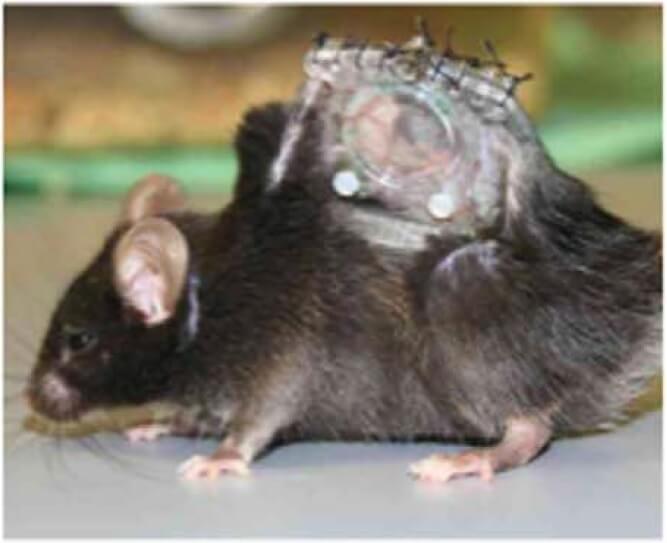
Examples of Animal Experiments at UVA
These experiments were recently conducted at UVA, and most were publicly funded.
A rapid electromechanical model to predict reverse remodeling following cardiac resynchronization therapy
Experimenters performed “open-chest surgery to induce myocardial infarction” (heart attacks) in “adult mongrel dogs” by permanently closing off a blood vessel to block blood flow to an area of the heart. One week later, the experimenters used cardiac ablation (a procedure that creates tiny scars on the heart with a catheter) to disrupt the heart’s electrical signals—causing the heart to beat irregularly. Experimenters anticipated that 20% of the dogs would “die before the planned study endpoint, and all or almost all of those deaths [would] be from arrythmia” (abnormal heartbeat) or “symptomatic heart failure.” MRI imaging was used to observe the injuries caused by heart attacks.
Impact of high-access exercise prior to and during early adolescence on later vulnerability to opioid use and relapse in male rats
Experimenters isolated adolescent rats in shoebox-style plastic cages. The rats were trained to press a lever to self-administer fentanyl and were given access to fentanyl infusions for six hours a day for 10 days. Then, the rats were subjected to an “abstinence phase” in which they were denied access to fentanyl for 14 days. Some rats had access to an exercise wheel, while others did not in order to determine whether rats who exercised more were more vulnerable to fentanyl addiction. A similar experiment was carried out at UVA in which adult rats were held solitarily in cages. The rats were trained to press a lever to self-administer fentanyl for 10 days. Access to fentanyl was then removed, and the rats went into withdrawal. The experimenters looked at sex differences in levels of fentanyl consumption/intake, relapse, and physical dependence.
Topical neck cooling prolongs survival of rats with intra-abdominal feculent sepsis by activation of the vagus nerve
Experimenters induced septic shock in rats by puncturing their intestines to allow fecal matter and bacteria to leak out. The rats would then endure widespread pain, experiencing fever, chills, diarrhea, difficulty breathing, lethargy, disorientation, multiple organ failure, and death. Experimenters wrapped the necks of some rats with an ice-filled rubber tube to determine whether cooling the neck would prolong survival. Other rats were allowed to suffer without any intervention—and these “control animals” died within eight hours. In comparison, the rats whose necks were cooled died within 11.4 hours.
A novel voluntary weightlifting model in mice promotes muscle adaptation and insulin sensitivity with simultaneous enhancement of autophagy and mTOR pathway
Experimenters confined mice to cages fitted with a platform that could be raised to different heights. The mice were trained to lift the platform by squatting and then standing up. After eight weeks of weightlifting, the experimenters cut tissue from both hind legs and took other measurements related to muscle mass and cardiovascular and metabolic functions. The mice were then killed and their bodies dissected.
Learning and memory dysfunction of nonsurgery cagemates of mice who have undergone surgery
Experimenters performed surgery on two mice—cutting incisions into the necks of the mice, removing soft tissue over the windpipe, and cutting tears into the carotid artery (a major blood vessel that supplies blood to the brain). These mice were placed in a cage containing three mice who hadn’t been subjected to surgery. Five days later, all five mice were subjected to a maze “to test their spatial learning and memory” followed by a “fear conditioning” test in which they received painful electrical shocks to their feet. The mice were then killed and their brains were removed.
Sleep fragmentation, electroencephalographic slowing, and circadian disarray in a mouse model for intensive care unit delirium
A UVA experimenter created a mouse model of ICU delirium. The abdomens of mice were cut open, and the animals were subjected to “simulated ICU-like” conditions.
Media Coverage Concerning Animal Testing at UVA
- December 14, 2019: “Physicians Group Files Complaint Against UVA for Using Live Animals in Surgery Training,” The Daily Progress
- May 26, 2020: “Sick Chinchillas Languish at Farms That Supply U.S. Researchers,” Science
- October 10, 2021: “Judge Permanently Revokes License of Notorious Chinchilla Supplier, Calls Violations ‘Absolutely Astounding’,” Animal Welfare Institute
- August 30, 2022: “How the USDA Fails to Enforce the Animal Welfare Act,” Counterpunch
- February 21, 2023: “Virginia bill would require animal testing facilities to submit info to the state,” The Virginian-Pilot
- June 12, 2023: “Amid ODU, EVMS and other university citations, Virginia senators call for more animal testing accountability,” The Virginian-Pilot
- February 8, 2024: “Bipartisan bill on animal testing transparency is downgraded to study after industry pushback,” The Virginian-Pilot
- June 7, 2024: “UVA researchers accused of animal neglect lose privileges,” The Daily Progress
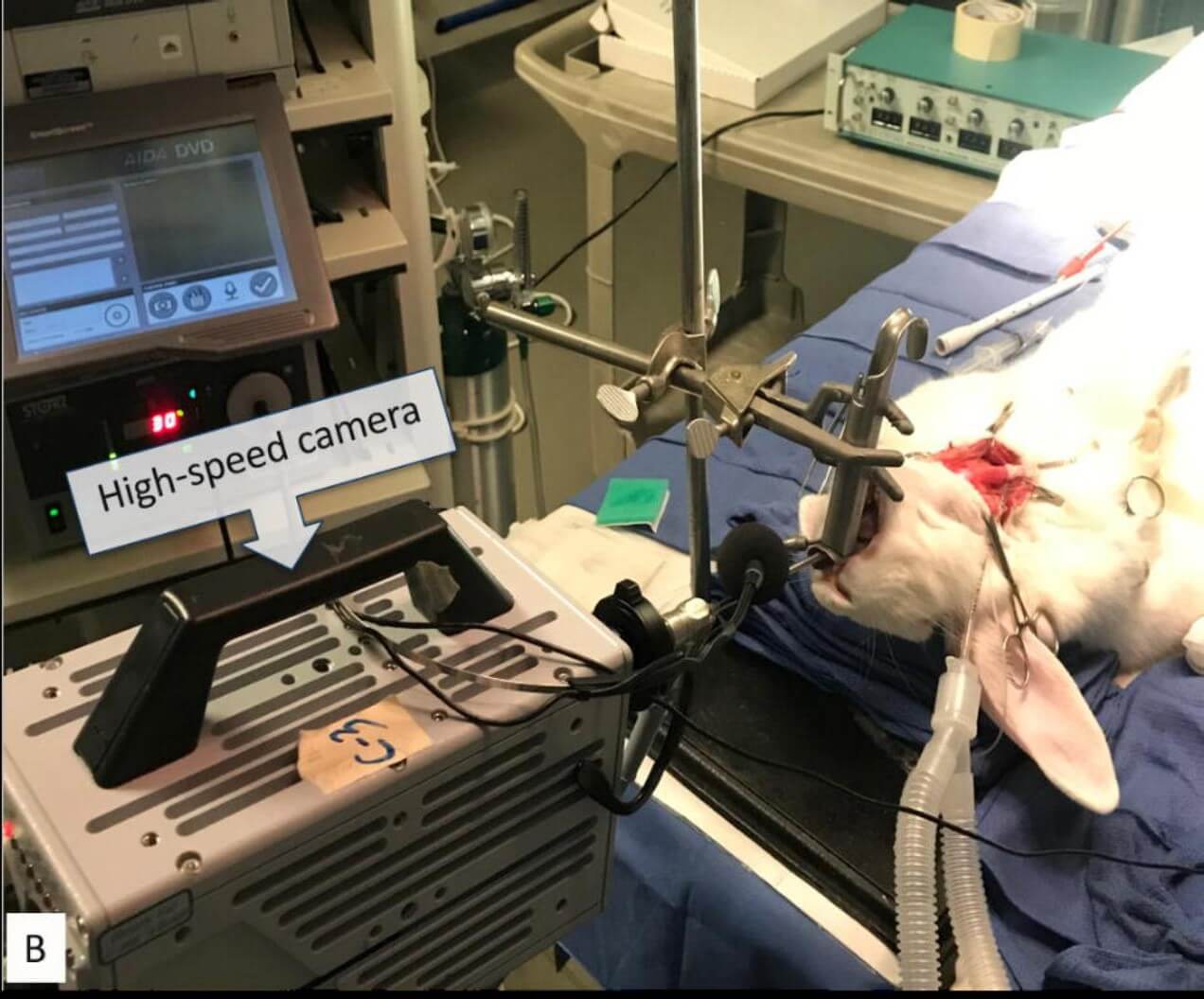
Public Funding for Experiments on Animals at UVA
In 2023, the Commonwealth of Virginia and its localities gave public universities more than $166 million for animal and non-animal research. Currently, no information is available indicating how much money is spent on animal experimentation in Virginia. The table below shows total annual research funds received by UVA for the past eight years, including public funding.
In 2025, UVA spent $10,385 of its funding on AAALAC “accreditation” fees.
| Year | State/Local Govt. | Federal Govt. | All Sources |
| 2014 | $3,691,000 | $205,865,000 | $358,576,000 |
| 2015 | $3,768,000 | $203,401,000 | $373,218,000 |
| 2016 | $4,366,000 | $210,980,000 | $397,458,000 |
| 2017 | $5,378,000 | $228,910,000 | $469,682,000 |
| 2018 | $7,828,000 | $250,168,000 | $551,761,000 |
| 2019 | $7,277,000 | $276,335,000 | $613,938,000 |
| 2020 | $8,780,000 | $300,348,000 | $652,002,000 |
| 2021 | $8,714,000 | $297,273,000 | $611,313,000 |
| 2022 | $9,520,000 | $332,993,000 | $662,658,000 |
| 2023 | $13,101,000 | $354,748,000 | $714,457,000 |
Source: Higher Education Research and Development Survey, Table 83 for FY 2014, Table 82 for FY 2015, and Table 5 for FY 2016–2023

